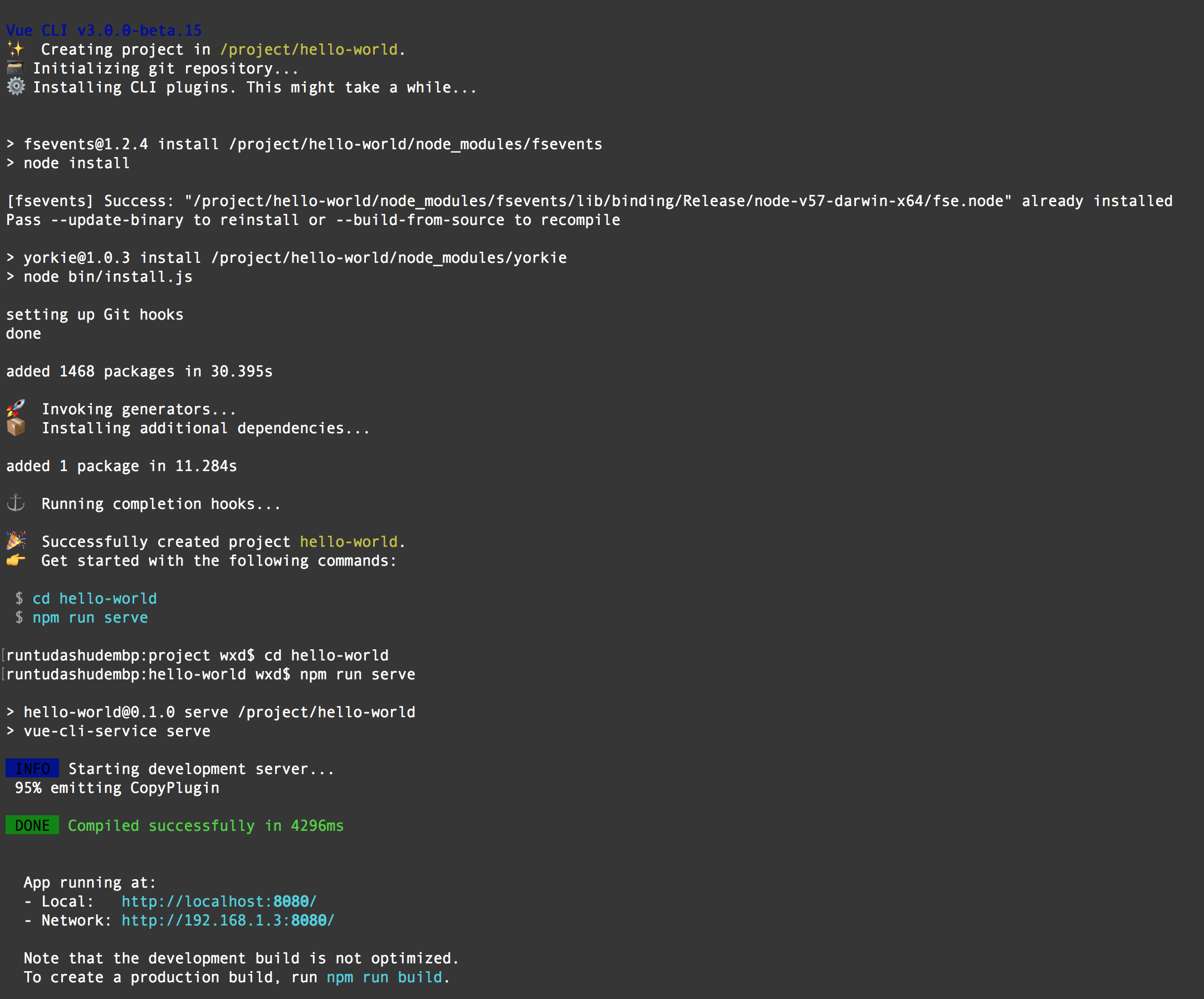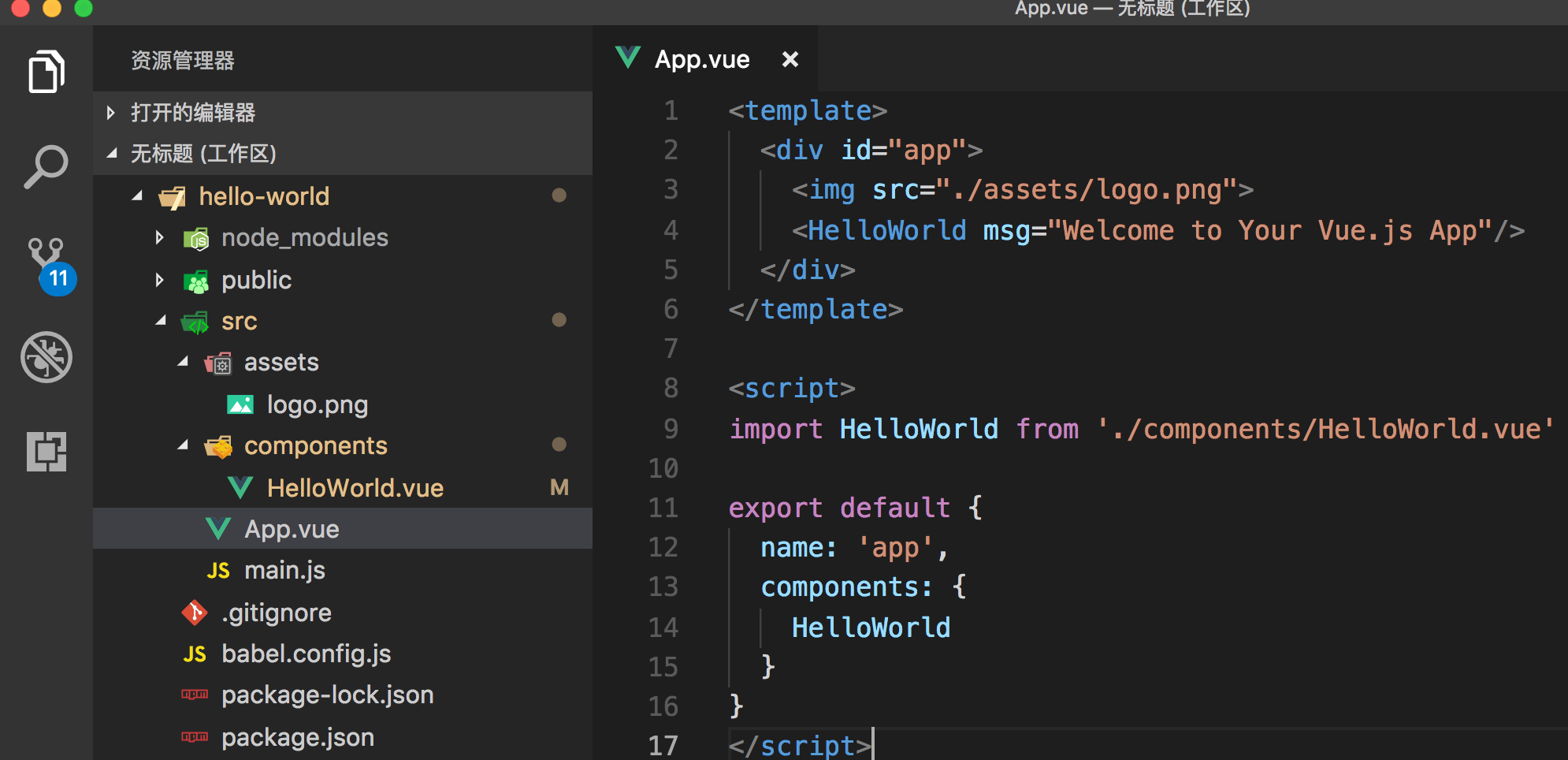入职第三天:vue-loader在项目中是如何配置的
这是我入职第三天的故事,在写这篇文章之前,先来看看咱们今天要讲的主角——vue-loader,你对它了解多少?
这是我今天的回答,确实,vue-loader是webpack的一个loader,用于处理.vue文件。
.vue 文件是一个自定义的文件类型,用类 HTML 语法描述一个 Vue 组件。每个 .vue 文件包含三种类型的顶级语言块 template、script和 style。
vue-loader 会解析文件,提取每个语言块,如有必要会通过其它 loader 处理(比如<script>默认用babel-loader处理,<style>默认用style-loader处理),最后将他们组装成一个 CommonJS 模块,module.exports 出一个 Vue.js 组件对象。
vue-loader 支持使用非默认语言,比如 CSS 预处理器,预编译的 HTML 模版语言,通过设置语言块的 lang 属性。例如,你可以像下面这样使用 Sass 语法编写样式:
<style lang="sass">
/* write Sass! */
</style>知道了什么是vue-loader之后,我们先来创建项目。为了快速地聊聊vue-loader,我在这里推荐用脚手架工具 @vue/cli 来创建一个使用 vue-loader 的项目:
npm install -g @vue/cli
vue create hello-world
cd hello-world
npm run serve这个过程我可以等等你们,because this might take a while...
当你在浏览器里输入localhost:8080之后,浏览器会友善地渲染出一个Welcome to Your Vue.js App的欢迎页面。
紧接着,我们需要打开你擅长的编辑器,这里我选用的是VSCode,顺手将项目导入进来,你会看到最原始的一个项目工程目录,里面只有一些简单的项目构成,还没有vue-loader的配置文件:
首先,我们需要在项目根目录下面新建一个webpack.config.js文件,然后开始我们今天的主题。
说到提取css文件,我们应该先去terminal终端去安装一下相关的npm包:
npm install extract-text-webpack-plugin --save-dev先来说个简答的方法,上代码:
// webpack.config.js
var ExtractTextPlugin = require("extract-text-webpack-plugin")
module.exports = {
// other options...
module: {
rules: [
{
test: /\.vue$/,
loader: 'vue-loader',
options: {
extractCSS: true
}
}
]
},
plugins: [
new ExtractTextPlugin("style.css")
]
}上述内容将自动处理 *.vue 文件内的 <style> 提取到style.css文件里面,并与大多数预处理器一样开箱即用。
注意这只是提取 *.vue 文件 - 但在 JavaScript 中导入的 CSS 仍然需要单独配置。
接下来我们再看看如何手动配置:
// webpack.config.js
var ExtractTextPlugin = require("extract-text-webpack-plugin")
module.exports = {
// other options...
module: {
rules: [
{
test: /\.vue$/,
loader: 'vue-loader',
options: {
loaders: {
css: ExtractTextPlugin.extract({
use: 'css-loader',
fallback: 'vue-style-loader' // 这是vue-loader的依赖
})
}
}
}
]
},
plugins: [
new ExtractTextPlugin("style.css")
]
}此举便将所有 Vue 组件中的所有已处理的 CSS 提取到了单个的 CSS 文件。
如何构建生产环境生产环境打包,目的只有两个:1.压缩应用代码;2.去除Vue.js中的警告。
下面的配置仅供参考:
// webpack.config.js
module.exports = {
// ... other options
plugins: [
new webpack.DefinePlugin({
'process.env': {
NODE_ENV: '"production"'
}
}),
new webpack.optimize.UglifyJsPlugin()
]
}当然,如果我们不想在开发过程中使用这些配置,有两种方法可以解决这个问题:
1.使用环境变量动态构建;
例如:const isDev = process.env.NODE_ENV==='development'
或者:const isProd = process.env.NODE_ENV === 'production'2.使用两个分开的 webpack 配置文件,一个用于开发环境,一个用于生产环境。把可能共用的配置放到第三个文件中。
借鉴大牛的经验这里提供一个网上标准的写法,名字叫做vue-hackernews-2.0,这里是传送门:https://github.com/vuejs/vue-hackernews-2.0。
其中共用的配置文件webpack.base.config.js的代码如下:
const path = require('path')
const webpack = require('webpack')
const ExtractTextPlugin = require('extract-text-webpack-plugin')
const FriendlyErrorsPlugin = require('friendly-errors-webpack-plugin')
const { VueLoaderPlugin } = require('vue-loader')
const isProd = process.env.NODE_ENV === 'production'
module.exports = {
devtool: isProd
? false
: '#cheap-module-source-map',
output: {
path: path.resolve(__dirname, '../dist'),
publicPath: '/dist/',
filename: '[name].[chunkhash].js'
},
resolve: {
alias: {
'public': path.resolve(__dirname, '../public')
}
},
module: {
noParse: /es6-promise\.js$/, // avoid webpack shimming process
rules: [
{
test: /\.vue$/,
loader: 'vue-loader',
options: {
compilerOptions: {
preserveWhitespace: false
}
}
},
{
test: /\.js$/,
loader: 'babel-loader',
exclude: /node_modules/
},
{
test: /\.(png|jpg|gif|svg)$/,
loader: 'url-loader',
options: {
limit: 10000,
name: '[name].[ext]?[hash]'
}
},
{
test: /\.styl(us)?$/,
use: isProd
? ExtractTextPlugin.extract({
use: [
{
loader: 'css-loader',
options: { minimize: true }
},
'stylus-loader'
],
fallback: 'vue-style-loader'
})
: ['vue-style-loader', 'css-loader', 'stylus-loader']
},
]
},
performance: {
maxEntrypointSize: 300000,
hints: isProd ? 'warning' : false
},
plugins: isProd
? [
new VueLoaderPlugin(),
new webpack.optimize.UglifyJsPlugin({
compress: { warnings: false }
}),
new webpack.optimize.ModuleConcatenationPlugin(),
new ExtractTextPlugin({
filename: 'common.[chunkhash].css'
})
]
: [
new VueLoaderPlugin(),
new FriendlyErrorsPlugin()
]
}然后看看用于开发环境的webpack.client.config.js的配置是如何写的:
const webpack = require('webpack')
const merge = require('webpack-merge')
const base = require('./webpack.base.config')
const SWPrecachePlugin = require('sw-precache-webpack-plugin')
const VueSSRClientPlugin = require('vue-server-renderer/client-plugin')
const config = merge(base, {
entry: {
app: './src/entry-client.js'
},
resolve: {
alias: {
'create-api': './create-api-client.js'
}
},
plugins: [
// strip dev-only code in Vue source
new webpack.DefinePlugin({
'process.env.NODE_ENV': JSON.stringify(process.env.NODE_ENV || 'development'),
'process.env.VUE_ENV': '"client"'
}),
// extract vendor chunks for better caching
new webpack.optimize.CommonsChunkPlugin({
name: 'vendor',
minChunks: function (module) {
// a module is extracted into the vendor chunk if...
return (
// it's inside node_modules
/node_modules/.test(module.context) &&
// and not a CSS file (due to extract-text-webpack-plugin limitation)
!/\.css$/.test(module.request)
)
}
}),
// extract webpack runtime & manifest to avoid vendor chunk hash changing
// on every build.
new webpack.optimize.CommonsChunkPlugin({
name: 'manifest'
}),
new VueSSRClientPlugin()
]
})
if (process.env.NODE_ENV === 'production') {
config.plugins.push(
// auto generate service worker
new SWPrecachePlugin({
cacheId: 'vue-hn',
filename: 'service-worker.js',
minify: true,
dontCacheBustUrlsMatching: /./,
staticFileGlobsIgnorePatterns: [/\.map$/, /\.json$/],
runtimeCaching: [
{
urlPattern: '/',
handler: 'networkFirst'
},
{
urlPattern: /\/(top|new|show|ask|jobs)/,
handler: 'networkFirst'
},
{
urlPattern: '/item/:id',
handler: 'networkFirst'
},
{
urlPattern: '/user/:id',
handler: 'networkFirst'
}
]
})
)
}
module.exports = config
最后来看看开发环境中的webpack.server.config.js的配置是怎么写的:
const webpack = require('webpack')
const merge = require('webpack-merge')
const base = require('./webpack.base.config')
const nodeExternals = require('webpack-node-externals')
const VueSSRServerPlugin = require('vue-server-renderer/server-plugin')
module.exports = merge(base, {
target: 'node',
devtool: '#source-map',
entry: './src/entry-server.js',
output: {
filename: 'server-bundle.js',
libraryTarget: 'commonjs2'
},
resolve: {
alias: {
'create-api': './create-api-server.js'
}
},
// https://webpack.js.org/configuration/externals/#externals
// https://github.com/liady/webpack-node-externals
externals: nodeExternals({
// do not externalize CSS files in case we need to import it from a dep
whitelist: /\.css$/
}),
plugins: [
new webpack.DefinePlugin({
'process.env.NODE_ENV': JSON.stringify(process.env.NODE_ENV || 'development'),
'process.env.VUE_ENV': '"server"'
}),
new VueSSRServerPlugin()
]
})
你可能有疑问,在 .vue 文件中你怎么检验你的代码,因为它不是 JavaScript。我们假设你使用 ESLint (如果你没有使用话,你应该去使用!)。
首先你要去安装eslint-loader:
npm install eslint eslint-loader --save-dev然后将它应用在pre-loader上:
// webpack.config.js
module.exports = {
// ... other options
module: {
rules: [
{
enforce: 'pre',
test: /\.(js|vue)$/,
loader: 'eslint-loader',
exclude: /node_modules/
}
]
}
}这样你的 .vue 文件会在开发期间每次保存时自动检验。
关于更多eslint的介绍,你可以翻看我之前写的文章《我是如何在公司项目中使用ESLint来提升代码质量的》,这篇文章里面有更多的应用小技巧。
文章预告:下一篇文章我将浅谈下css-modules的配置以及.editorconfig。最新文章都会第一时间更新在我的公众号<闰土大叔>里面,欢迎关注~
共同学习,写下你的评论
评论加载中...
作者其他优质文章








